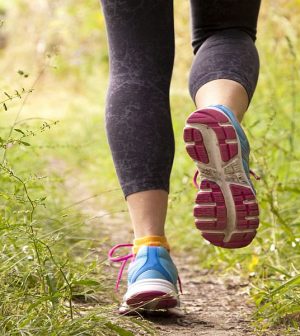- Navigating Your Midlife Crisis: Embracing New Possibilities
- City Raccoons Showing Signs of Domestication
- Mapping the Exposome: Science Broadens Focus to Environmental Disease Triggers
- One Week Less on Social Media Linked to Better Mental Health
- Your Brain Changes in Stages as You Age, Study Finds
- Some Suicide Victims Show No Typical Warning Signs, Study Finds
- ByHeart Formula Faces Lawsuits After Babies Sickened With Botulism
- Switch to Vegan Diet Could Cut Your Greenhouse Gas Emissions in Half
- Regular Bedtime Does Wonders for Blood Pressure
- Dining Alone Could Mean Worse Nutrition for Seniors
Hey Runners, Be Sure to Choose the Right Shoes

The only equipment you really need to go running are running shoes. But choosing a pair can often feel like a shopping marathon.
There’s no shortage of big box sporting goods stores, but ask the staff at a local running club for suggestions about where to shop. The salespeople at a specialty shoe store should be better able to suggest the right styles for your feet.
Look for lightweight choices. For example, 8 ounces or less for a woman’s size 8, and 10 ounces or less for a man’s size 9.
The shoes should have little or no heel-to-toe “drop” — that’s a difference in thickness from the heel cushion to forefoot cushion. And they should be “neutral” — skip any motion control or stability features, which can actually interfere with normal foot motion.
As with all footwear, shop at the end of the day when feet are at their largest. The toe box should be wide enough so you can wiggle your toes and have at least a half-inch of space between them and the front tip of the shoe — about the width of a thumb. Don’t buy a tight shoe thinking it will “give” over time. And, of course, try out your selections in the store.
If you’re replacing an existing pair of running shoes, don’t wait until they’re no longer usable. You want to gradually transition to the new pair. At first, wear them for just a few minutes of each run, and then for longer and longer periods of time.
Some people replace their shoes every 350 miles, but that’s not a hard-and-fast rule. Check the soles daily. If lower layers of material are showing through in spots, you’re overdue.
If you walk rather than run for fitness, you might be most comfortable in a walking shoe, which typically has a more flexible sole, according to Consumer Reports. If you participate in a few different activities, check out cross-trainers rather than buying a separate pair of shoes for each type of exercise.
More information
The American College of Sports Medicine details what to look for when shopping for running shoes.
Source: HealthDay
Copyright © 2025 HealthDay. All rights reserved.










